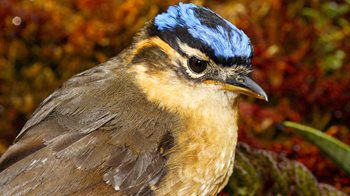
Responsible environmental management is central to the Porgera operation. The Porgera Joint Venture (PJV) is committed to good environment stewardship and achieves this through implementation of an Environmental Management System (EMS) that was certified to the ISO 14001 standard in December 2012 and recertified in 2015, 2018 and 2021. A team of environmental professionals takes responsibility for monitoring compliance with permit conditions and PJV standards for water conservation, climate change, biodiversity, mine closure and incident reporting.
The EMS helps to drive environmental performance by ensuring a systematic approach to environmental management and continual improvement in areas such as water, energy and waste disposal. Certification to ISO 14001 provides assurance the right environmental programs and controls are in place and they are being applied consistently and effectively in reducing environmental impacts. In 2009, Porgera was awarded certification to the International Cyanide Management Code (ICMC) for the safe transport, handling and use of sodium cyanide for gold processing, and was recertified in 2012, 2016 and 2020.
Compliance, Risk and Impact Assessment
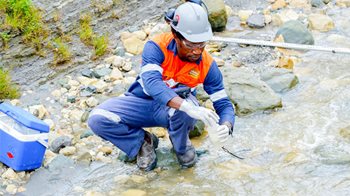
PNG Government approval for riverine disposal was granted only after careful review of Porgera's Environmental Plan and was contingent upon the mine demonstrating, through ongoing monitoring, that river water quality further downstream meets ambient quality standards set to protect public health (including drinking water guidelines) and aquatic ecosystems. The PJV environmental permit requires extensive river monitoring and strict compliance with discharge and monitoring requirements.
Porgera has a comprehensive monitoring program for ensuring the effectiveness of the tailings treatment system, checking compliance with Environmental Permits and assessment of impacts on rivers downstream from the mine.
PJV works closely with Australia’s national science agency, the Commonwealth Scientific and Industrial Research Organization (CSIRO) to monitor impacts on the river system downstream from the mine. The verdict to date is the impacts of the waste disposal scheme are within the predictions made in the environmental plan prior to development of the mine in 1990 – a state of affairs which certification to ISO 14001 is helping to confirm.
The mine compiles all of the environmental monitoring results into Annual Environment Reports that are available here
2015-Porgera-AER-Final,
2016-Porgera-AER-Final,
2017-Porgera-AER-Final,
2018-Porgera-AER-Final, 2019 Porgera AER - Final and demonstrates the Company’s commitment to transparency.
Land Reclamation
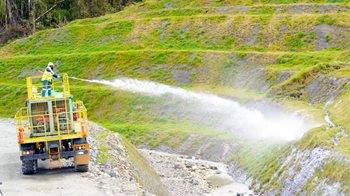
Progressive reclamation of disturbed land is carried out as soon as its use for mining purposes has been completed. Reclamation is carried out in two stages, the first involves applying fertilizer and planting a range of grass and legume species in order to stabilize the soil and establish a protective plant litter layer which will recycle nutrients. PJV uses a hyrdroseeder for applying seed and fertilizer to graded slopes while a helicopter seeding-bucket is used for steep, inaccessible areas, such as the open pit.
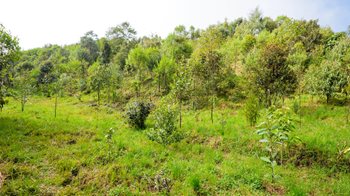
The second stage of reclamation involves shrub and tree planting, with the aim of establishing a self-sustaining vegetation community. Local village groups are contracted to grow tree seedlings which are then transplanted at the mine site. Trees planted in 2004 are well established and provide habitat for insects, birds and lizards.
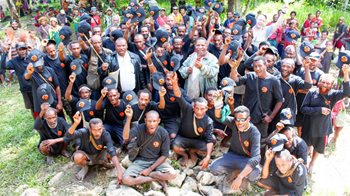
PJV has partnered with Conservation International (CI) and provided funding and logistical support for biodiversity surveys at the Kaijende Highlands near the mine and the Strickland Headwaters. New species of frogs, reptiles, plants and insects were discovered from these surveys extending the known range of mammals and birds.
PJV works in partnership with renowned American anthropologist and conservationist Dr William Thomas who developed the Forest Stewards Program. He has recorded the Hewa people's knowledge of their forests' ecology and has published a field guide book dedicated to local bird life. The Forest Stewards Initiative with the people of the Strickland River headwaters aims to conserve biological and cultural values of the forest and their people. Local communities are compensated to secure their way of life and continue to keep their language, traditions and forest into the next generation.
In June 2016, PJV signed a Memorandum of Understanding (MOU) for two pilot projects with the Conservation and Environment Protection Authority (CEPA) and the Climate Change and Development Authority (CCDA). The pilot project with CEPA is aimed at demonstration of the Hewa Forest Stewards Program at the Strickland Headwaters as leading practice for achieving the objectives of the
Conservation Areas Act and which is deemed to be sustainable in the long run.
The project with CCDA involves the Strickland Headwaters as a pilot project under the REDD+ Mechanism that is consistent with the
Climate Change (Management) Act 2015, and is designed to test and evaluate the newly developed system and processes for securing carbon credits as adequate compensation for maintaining the carbon sequestration capacity of the forests, biodiversity, traditional knowledge and cultural heritage. More information on the Forest Stewards Program is available on the following website:
http://www.newguineaconservation.org.